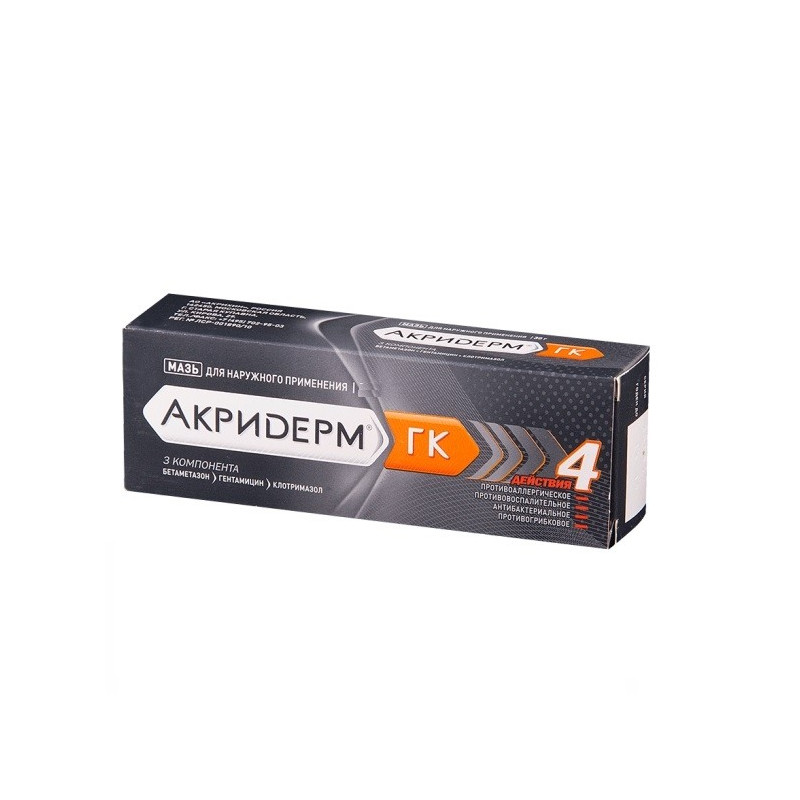



 All payments are encrypted via SSL
All payments are encrypted via SSL
 Full Refund if you haven't received your order
Full Refund if you haven't received your order
Ointment
100 g ointments contain:
active substances: betamethasone dipropionate in terms of 100% substance - 0.064 g, Clotrimazole in terms of 100% substance - 1 g, Gentamicin sulfate in terms of gentamicin - 0.1 g;
Excipients: propyl para-hydroxybenzoate (nipazol), liquid paraffin (liquid paraffin), isopropyl myristate, petroleum jelly.
Tuba 15
Akriderm GK - a combined drug, has anti-inflammatory, antiallergic, antibacterial and antifungal (fungicidal) effect. Gentamicin - a broad-spectrum antibiotic from the group of aminoglycosides, bactericidal. Highly sensitive Gram-negative microorganisms - Proteus spp. (indpositive and indole-negative), Escherichia coli, Klebsiella spp., Salmonella spp., Shigella spp., Campylobacter spp., Staphylococcus spp. (methicillin-resistant). Sensitive: Enterococcus faecalis, Serratia spp., Pseudomonas spp., Acinetobacter spp., Citrobacter spp. Resistant: Neisseria meningitidis, Treponema pallidum, anaerobic microbes: Streptococcus spp. (except Streptococcus pneumoniae), Enterococcus faecalis; Providencia rettgeri. Betamethasone - glucocorticosteroid, has a local anti-inflammatory, anti-edematous, anti-allergic effect.
Clotrimazole is an antifungal agent from the group of imidazole derivatives for topical use. It has an effect due to a violation of the synthesis of ergosterol, which is an integral part of the cell membrane of fungi. It has a wide spectrum of action. It is active against pathogenic dermatophytes (Trichophyton rubrum, Trichophyton mentagrophytes, Epidermophyton floccosum, Microsporum canis), yeast and mold fungi (Candida spp., Torulopsis glabrata, Rhodotorula spp., Pityrosporum orbicrophy.,
Simple and allergic dermatitis (especially complicated by secondary infection), diffuse neurodermatitis (including atopic dermatitis), limited neurodermatitis (including simple chronic lichen), eczema, dermatomycosis (dermatophytosis, candidiasis, varicolor versicolor), especially localization in the groin and large folds of the skin.
Hypersensitivity to any of the components of the drug, skin tuberculosis, skin manifestations of syphilis, chicken pox, herpes simplex, skin post-vaccination reactions, open wounds, children's age (up to 2 years).
During pregnancy (especially in the first trimester), topical application of the ointment in pregnant women is allowed only in cases where the intended benefit to the mother outweighs the potential risk to the fetus. In such cases, the use of the drug should be short and limited to small areas of the skin. It is not known whether the components of the drug are excreted in breast milk. Therefore, when prescribing Acryderm GK ointment during lactation, it is recommended to stop breastfeeding.
Outwardly. Acryder GK ointment is applied to the affected skin, slightly rubbing a small amount 2 times a day. The duration of treatment is determined individually and depends on the nosological form and severity of the disease. With ringworm, the average duration of treatment is 2–4 weeks. If clinical improvement in the near future does not occur, it is necessary to clarify the diagnosis or change the treatment regimen.
Itching, burning, irritation, dry skin, folliculitis, hypertrichosis, steroid acne, hypopigmentation, allergic reactions. When using occlusive dressings - maceration, infection, skin atrophy, stretch marks, prickly heat. With prolonged treatment or application to a large surface - the development of systemic side effects: weight gain, osteoporosis, high blood pressure, edema, ulceration of the gastrointestinal mucosa, exacerbation of hidden foci of infection, hyperglycemia, agitation, insomnia, dysmenorrhea.
Avoid contact with eyes.
When a persistent bacterial or fungal microflora appears, the drug should be discontinued, appropriate therapy should be prescribed.
Due to the fact that in children the area of the skin in relation to body weight is larger than in adults, and the epidermis is also underdeveloped, when the drug is used externally, a proportionally larger amount of active substances can be absorbed and, consequently, there is a greater risk of systemic side effects. Use the drug in children as soon as possible and in compliance with all precautions.
Symptoms: phenomena of hypercortisolism.
Treatment: gradual withdrawal of the drug. Symptomatic therapy. If necessary - correction of electrolyte disorders.
At a temperature of 15 to 25 ° C. Keep out of the reach of children.
2 years
